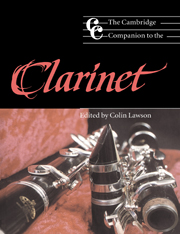Book contents
- Frontmatter
- 1 Single reeds before 1750
- 2 The development of the clarinet
- 3 The clarinet family
- 4 The development of the clarinet repertoire
- 5 Players and composers
- 6 The mechanics of playing the clarinet
- 7 Teaching the clarinet
- 8 Playing historical clarinets
- 9 The professional clarinettist
- 10 The contemporary clarinet
- 11 The clarinet in jazz
- 12 The clarinet on record
- Notes
- Appendices
- Select bibliography
- Index
7 - Teaching the clarinet
Published online by Cambridge University Press: 28 September 2011
- Frontmatter
- 1 Single reeds before 1750
- 2 The development of the clarinet
- 3 The clarinet family
- 4 The development of the clarinet repertoire
- 5 Players and composers
- 6 The mechanics of playing the clarinet
- 7 Teaching the clarinet
- 8 Playing historical clarinets
- 9 The professional clarinettist
- 10 The contemporary clarinet
- 11 The clarinet in jazz
- 12 The clarinet on record
- Notes
- Appendices
- Select bibliography
- Index
Summary
Introduction
Today's young musician is growing up in a social and musical world considerably different from even the recent past. The methods and theories of such music educators as Carl Orff, R. Murray Schafer, John Paynter and Keith Swanwick have become widely known and assimilated (if, perhaps, unconsciously) and the more recent emergence of examinations which engage the student in original composition (as well as performing and ‘listening’) has produced a new generation of young musicians more creative in their thought, more emotionally mature and more vividly aware of their surroundings – they are, to use the contemporary term, more ‘street-wise’. Our pupils are no longer to be seen as receptacles into which we ‘drop’ information – and thus we must acknowledge that the role of the teacher ‘is transformed from that of musical “director” to that of pupil facilitator: stimulating, questioning, advising and helping, rather than showing or telling’. We live in times of change and development, fin-du-siècle is a period of rethinking and innovation. It is in this spirit that we consider the various facets of clarinet teaching in the following pages.
The teacher
As instrumental teachers we are concerned with two distinct but interrelated disciplines. On the one hand, we must teach our pupils the skills necessary to play their instruments to the best of their abilities, and on the other, we must help them to develop their sense of artistry and musicianship. Drawing from students that subtle ability to communicate something of their innermost self through the medium of musical performance is simultaneously a most demanding and stimulating challenge. Without musical 'personality' performances will remain uninspired and the central message which music communicates is lost.
- Type
- Chapter
- Information
- The Cambridge Companion to the Clarinet , pp. 123 - 133Publisher: Cambridge University PressPrint publication year: 1995
- 2
- Cited by



